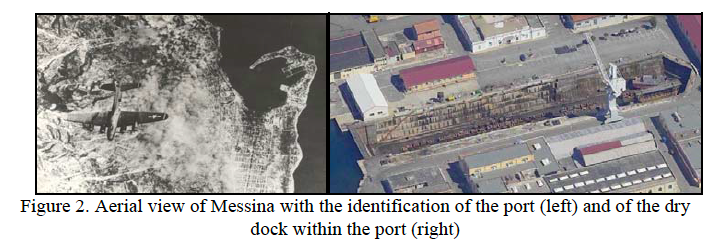Seismic Vulnerability Assessment of a MilitaryDry Dock in Messina
studies conducted on the military dry dock in the Portof Messina (built in 1861), to assess the seismic vulnerability
1. INTRODUCTION
The arsenal is defined as a few complex establishment of mechanical and marine plants in order to build, repair and maintain Navy vessels, including all the weapons and equipment owned. Besides including ports and docks, a maritime arsenal includes all sorts of workshops, experimental laboratories, warehouses and office management and administration as well.
The idea of naval arsenal was conceptually born during the Arab period, probably as a process of evolving environment in old formulas dating back to classical antiquity.
From the sixteenth century and to the present day, historians, writers, chroniclers and scholars of Messina have always taken for granted that Messina, since the beginning of its history, had a large arsenal - "the most important in the Mediterranean" . This theory was justified by many resources of city's history: the city had a strong seafaring and commercial vocation and was in the center of the main maritime trade for a couple of millennia, being a compulsory transit point on the busiest routes.
There is a gravity type dry dock inside the Military, called “Bacino in Muratura”, in use today in by the Agenzia Industrie Difesa “Militarsen” of Messina. According to the chronicle it was built by the Genio Civile with many difficulties.
A campaign of surveys carried out in 2003 revealed a stratigraphic sequence of unusual heterogeneous material elements in the quoin of the internal dock, used during the realization possibly in order to counter water and slime infiltration emerged during the excavation.
The stone cladding (thickness about 80 cm) rests on a pozzolanic conglomerate (about 70 cm) constructed as a water infiltration barrier on the base slab.
Two rows of bricks found along the vertical direction were used as a subbase for finished paving and for the foundation slab (thickness of about 4.00 m). The pozzolanic mixture used (lime, crushed stone and pozzolana) was poor in pozzolana and rich in lime, therefore used as a binder of gravel and other inert material. The obtained composite that does not show its mechanical fatigue resistance and properties allows water filtration compromising the correct execution of the work. Today this area shows the same problems.
This structure suffered severe damage by the famous earthquake in 1908, with the natural consequence of inactivity of the basin up to 1911.
The new structure was built about 1.70 m off-axis relative to the first one.
The slab was investigated in the 2005 campaign that highlighted the consistency (thickness of about 5 m) and good structural quality. It rests on a layer of stones vary depending on a concave surface upward from 0.90 to 1.80 m.
The walls of the “new reservoir” are covered with blocks, packed with the natural conglomerate (polygenic conglomerate – in slang pudding) found and remove during the excavation using mines.
The extension does not have exhaust galleries, which are present in the section of "old dock", but contains drains and pipes laid under the extrados'slab.
In 1976, the Genio Civile realized the last important reinforcement for the basin. The area of the gargame was covered with plates of 15 mm with tie beams in the front of North and South input threshold.
2. HISTORICAL FRAMING
The seismic vulnerability assessment has been carried out on a military dry dock located inside the Messina naval shipyard. The first building structures and the first activities date from the roman period and had a strong development during the Arabian domination in Sicily. From the urbanistic point of view, the complex of structures is located in a well defined area, detached from the city, and is provided with suitable defensive works to protect military activities.
As military shipyard; the dry dock construction was carried out few years after The Italian Unification. In that period there was an increase in size and tonnage of the ships – supported with the use of steel technologies in the ship construction
and of steam engines - and therefore the need to set up a suitable area to be equipped for the maintenance of military and merchant ships raised up.
So Civil Engineers offices planned the project and the structural works started on 1869. On 1876 the dry dock construction was completed.
The dry dock, planned as a large basin 104 m in length and covering an area of 21500 m2, worked without interruption until 1908 when the well known earthquake of Messina damaged the structure of the dock closure device: the dry dock was flooded and a ship that was there in maintenance sank. After restoration and safety works, the dry dock started work again on 1912.
After the Second World War, with the development of national economy, with the increasing of ship traffic and the use of large size ships, the need to enlarge the dry-dock raised up. So the dry dock have been lengthened of 50 m. On 1954 all
construction works have been concluded.
2.1 The construction technique
The dry dock in Messina, named “at gravity”, is one of the first examples planned in Italy with this kind of technique. Unfortunately the original documentation of the dry dock project drawn up by the two worker directors, F. Damiani and G.
Medici engineers, was nowhere to be found. Only a descriptive information referred to the object it has been possible to find in the text drawn up by general F.
Martini focussed on the latest construction of dry dock in the Venice naval shipyard. The available information evidences that the excavation, having sides with a slope of about 45°, has been made applying open cut techniques. Explosives were
used to cut the polygenic conglomerate (pudding), located 60 cm below the ground level.
The following construction of the dry dock structure, has been probably carried out using a mobile bridge where lines were overlapped to permit the movement of the vehicles used for conglomerate transportation (Figure 1). Finally, filling material was used to fill up the hollow space between the structure and the rock.
The walls and the bed of the dry dock have been probably made with pozzolanic material, sand and gravel aggregates, adding hydrated lime as binder material.

3. GEOLOGICAL AND GEOTECHNICAL FRAMING
The area, when dry dock was realized, is characterized by a narrow peninsula which start to the cost of arching in the sea off Messina thus creating a protected natural dock for landing of ships (Figure 2). The deposits in this area were subjected at different survey campaigns, especially in recent years (September 2005 and July 2009), in order to get a precise characterization of the subsurface near the dry dock.

PROSEGUE IN ALLEGATO --->




